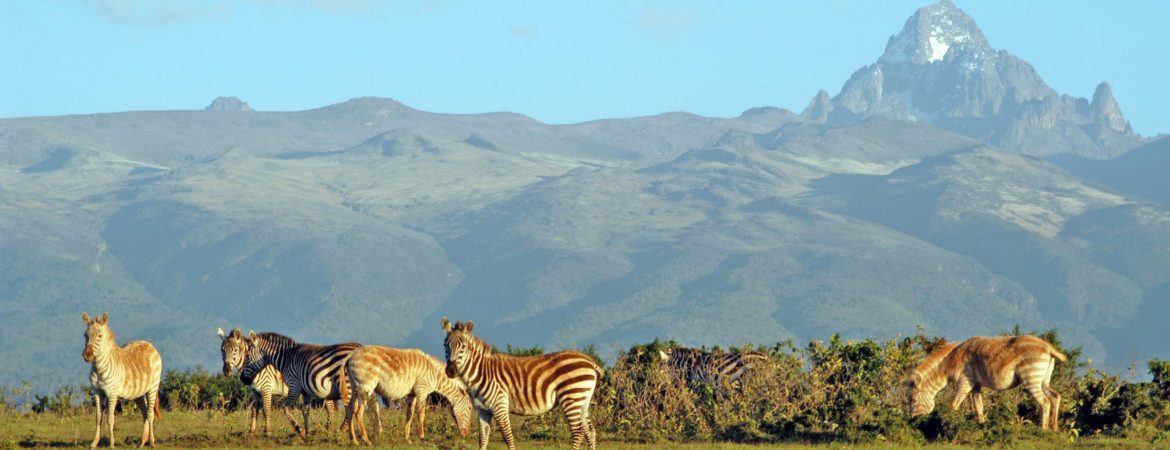MT. KENYA NATIONAL PARK

Mount Kenya National Park sounds as the second tallest mountain in Africa with rewardable beautiful scenery and a good place for breath taking. Ideally it is a beautiful wilderness composed of lakes, glaciers, dense forest, mineral springs, variety of wildlife species and as it is ranged on high altitude it attracts with wild game, alpine vegetation and unique montane. Travelers who visits the park get amazed with remarkable experience of mountain climbing, camping as well as visiting caves with the mountain’s rugged glaciers- clad peaks as you gain the impressive backdrop of this area.
However, the park was established in 1949 to protect Mount Kenya, diversity of wildlife species and surrounding environment which are habitat for wild animals. The park is under the protection of ‘’KWS’’ Kenya wildlife Service.
Mount Kenya national park measures 715 square kilometers of its low land and the forest reserve covers an area of 705 square kilometers. When the total area is combined forms 1,420 square kilometers of the UNESCO World Heritage site. The park is surrounded with volcanic sediment and high volume of fresh water that flow down the slopes thus making a favorable area for agriculture.
Initially, the area was a forest reserve before turning it into a national park. And in April 1978 the area was designated as a UNESCO Biosphere Reserve and recently the national park was encircled by the forest reserve. They are both combined the national park and forest reserve, in 1997 become a World heritage site.
Most people come to the Mount Kenya National Park to climb the Mountain. There are seven routes up the mountain, which has three peaks. Most tourists climb to Point Lenana which at 4985m is the third highest peak. Only climbers with advanced technical climbing ability are allowed to attempt the other two peaks.
You will pass through several different eco-systems on your ascent from tropical forest which is home to Buffalo and Elephant to the Bamboo forest, then the upland heath which is home to many strange plants such as the Giant Lobelia and Rosette plants. This then gives way to a barren land of rock, ice and snow.
It is recommended that you spend a minimum of three nights while ascending the mountain – this allows your body to acclimatize so that you do not suffer from altitude sickness. The best time of year to attempt the climb is from the middle of January till the end of February and between August and the end of September. These are the two dry seasons, as during the short and the long wet season it is always overcast and visibility is poor.
Activities in Mount Kenya National Park
- Game drive viewing: Game viewing in Mt. Kenya national park is excellent throughout the year. It is advisable to use a 4WD for a better experience since it has good ground clearance.
- Nature walk: This guided nature walk can be done in forest reserve where you can get amazed with green vegetation as you walk through the forest trails while listening to sweet melodies of birds. On your guided nature walk traveler can be able to see unique tree species, birds as well as primates like black and white colobus monkey, mole rats, white tailed mongoose, Genet cats, Giant forest Hog, bush pig many more.
- Mountain climbing: Mountain climbing is the most famously done activity in here and requires one to be physically fit to be able to trek till the third peak that rises 4.895meter and it takes seven days or ten days to reach the top where you get rewarded with beautiful scenery of the land scape.
- Camping: This is one of the main activities done in here since along the mountain there is a safe camping point offered to travelers who like camping. At night, travelers get attracted to night stars as well as wilderness sounds.
- Birding: On your birding tour in this national park, you will encounter numerous beautiful bird species such as Olive Ibis, Ayres’s hawk eagle, African Crowned Eagle, Long tailed Widowbird, Abyssinian Owl, Cape Eagle Owl, Abbott’s Starling, Lesser Kestrel and many other species.
